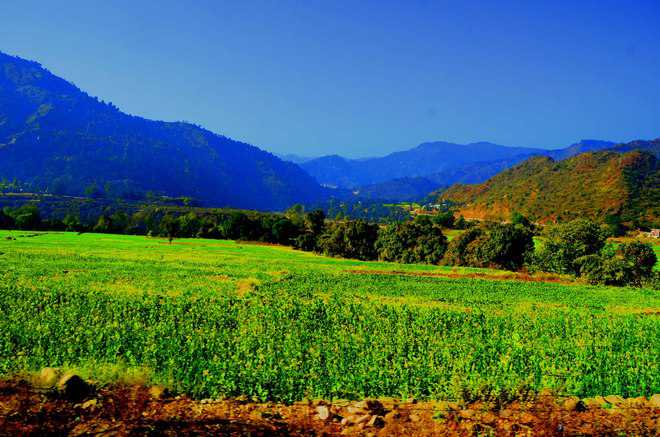
Neena Sharma
Tribune News Service
Dehradun, May 1
Uttarakhand has a topography similar to Sikkim but still it lags behind that hill state in going fully organic. While Sikkim brought 75,000 hectares under organic farming last year and declared itself an organic state, Uttarakhand has managed to bring about 68,528 hectares under organic agriculture in the last few years.
The efforts towards making Uttarakhand fully organic started in 2002. The biggest constraints for Uttarakhand farmers are the non-availability of organic manure, inadequate marketing linkages and a committed policy to promote organic crops by declaring a minimum support price (MSP) for cereals.
“It takes minimum three years for a farm to be completely organic. We have insufficient organic manure, which comes from animal and agriculture waste, to achieve the goal. Contrary to the government claims, the livestock population is decreasing in the state and hence there will always be a shortage of organic manure. To promote organic farming, an entire ecosystem has to be developed. Another constraint is lack of market response. Farmers do not adopt organic farming when produce is not sold. There is no organised market for organic products,” says SP Bahuguna, an organic farmer in Vikasnagar, Dehradun.
Rain-dependent agriculture
As farming in hilly districts is dependent on rain, the chances of use of chemical fertilisers are remote in Uttarakhand. This indeed is an advantage that the state decided to build upon when efforts in organic farming started seven years ago. While organic food offers a hope against pesticide-laden food invading our dining tables, it can also bring higher dividends to farmers in the state.
Seeds stored in dry gourds
For centuries, farmers in the hills have toiled on their lands to grow a variety of cereals with the help of seeds carefully stored in dry gourds and pumpkins. This traditional practice of preservation of seeds has stood the farmers in good stead and given them a substantial yield year after year.
“We are building on this inherent advantage and urging farmers to continue with the traditional practice of using seeds and chemical-free manure. Some improvements in the production of chemical-free manure are also being witnessed. Farmers are being taught how to use organic manure in a manner that is both scientific and productive,” said Dr Ranbir Singh, Additional Chief Secretary, Agriculture.
The government’s role effectively has been to teach farmers how to scientifically decompose farm waste and cow dung. It is offering training in manure production and providing subsidy of 80 per cent of the cost to farmers who opt for organic composting and vermin compost. Similarly, clusters of bio-villages producing organic crops are also being promoted.
Rudraprayag organic district
There are around 95,000 farmers engaged in organic farming on about 68,528 hectares in the state. This means these farmers can sell their organic produce internationally.
Rudraprayag has been declared an organic district. Ramdana and soyabean are cultivated in Jakholi, Agustmuni and Ukhimath blocks there. Vikasnagar, Sahaspur, Raipur and Doiwala blocks in Dehradun and Udham Singh Nagar and Haridwar districts are the major contributors towards the organic rice production in the state. Gairsain, Chamoli and Deval are producing rice that is sold in the Gujarat market.
A Sonepat-based firm purchases rice produced in Uttarakhand and exports it to far eastern countries and the USA under the brand name of Kohinoor rice. The organic producer groups have been trained to semi-process and package products at the village level itself. A total of 40 organic commodities, including detergents, have been developed.
Aromatic plants
Women self-help groups in Joshimath are also engaged in the production of organic rosewater and oil. “We also focus on diversification as part of our efforts to link women groups growing rose, mentha and other aromatic herbs with the Centre for Aromatic Plants to help them learn distillation and production of oil,” says Vinay Kumar, MD, Uttarakhand Organic Commodity Board.
Organic restaurant
Cereals such as Mandva, Jangora, soyabean (both white and black called Bhatt) are coveted by connoisseurs of organic food mainly due to their health benefits. Small haats are organised for local farmers to sell their produce of vegetables and salads.
However, those engaged in organic farming, especially small farmers, continue to face difficulty in accessing markets to sell their produce. Haritima, an organic restaurant, was closed as it received a lukewarm response.
Barah Anaaj—farming of 12 mixed foodgrains
Barah Anaaj is a mixed farming system wherein farmers grow 12 foodgrains on the same piece of land. These 12 crops include ramdana, rajma, ragi (finger millet), mangjeer, green gram, buck wheat, lobia, horse gram, traditional soya called Math, and a few other crops. This traditional farming method is practised in Tehri, Almora, Chamoli and Ranikhet.
Vijay Jardhari, a traditional farmer from the Hemwal valley in Tehri Garhwal district, has conserved 300 seeds of rajma, 20 varieties of paddy and cowpea. Jhardari grows Thap Chini (Tehri and Kumaon), a traditional variety of paddy that attains a height of 120 cm and gives at least 72 quintals of rice on one hectare. “Our ancestors used to follow this practice for the simple reason that in case one crop fails due to climatic conditions, the others can be harvested. The system also ensured less pests and diseases,” he says. The practice of growing Barah Anaaj is generally followed in the kharif season because during the rabi season, the weather is cold. This system is already on the brink of disappearance in the state due to popularisation of mono-farming or a single crop to boost the income of farmers.



























